|
|
|
Sort Order |
|
|
|
Items / Page
|
|
|
|
|
|
|
| Srl | Item |
| 1 |
ID:
078027
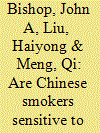

|
|
|
|
|
| Publication |
2007.
|
| Summary/Abstract |
We estimate cigarette price and income elasticities for urban China, 1995. We find an overall cigarette price elasticity of 0.5, which lies between previous estimates. This implies that a 10% increase in price would result in a decline in cigarette consumption of 4.5 billion packs and would raise Y34 billion in additional tax revenue.
|
|
|
|
|
|
|
|
|
|
|
|
|
|
|
|
| 2 |
ID:
092778


|
|
|
|
|
| Publication |
2009.
|
| Summary/Abstract |
This paper aims to investigate and explain the performance of the Brazilian demand for automotive fuels in the period 1970-2005. It estimates the price and income elasticities for all the available fuels in the automotive sector in the country: gasoline, compressed natural gas (CNG), ethanol and diesel. The analysis of the expenditure allocation process among these fuels is carried out through the estimation of a linear approximation of an Almost Ideal Demand System (AIDS) model. Two estimation methods were implemented: the static (through a seemingly unrelated regression) and a dynamic (through a vector error correction model). Specification tests support the use of the latter. The empirical analysis suggests a high substitutability between gasoline and ethanol; being this relation higher than the one observed between gasoline and CNG. The study shows that gasoline, ethanol and diesel are normal goods, and with the exception of ethanol, they are expenditure elastic. CNG was estimated as an inferior good.
|
|
|
|
|
|
|
|
|
|
|
|
|
|
|
|
| 3 |
ID:
081894


|
|
|
|
|
| Publication |
2008.
|
| Summary/Abstract |
China's sectoral trade composition, product quality mix, and the import content of processing exports have all changed substantially during the past decade. This has rendered trade elasticities estimated using aggregate data highly unstable, with more recent data pointing to significantly higher demand and price elasticities. Sectoral differences in these parameters are also very wide. All this suggests greater caution should be exercised when using historical data to simulate the response of China's economy to external shocks and exchange rate changes. Analyses based on models with estimated coefficients largely representative of China in the 1980s and 1990s are likely to turn out to be wrong, perhaps even dramatically.
|
|
|
|
|
|
|
|
|
|
|
|
|
|
|
|
| 4 |
ID:
130973
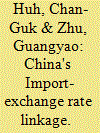

|
|
|
|
|
| Publication |
2014.
|
| Summary/Abstract |
This paper examines how the China-bound exports of Japan and Korea are related to exchange rates, motivated by the fact that processing trade makes up a large proportion of China's trade, and that Japan and Korea are the leading source countries for processing imports. Because processing imports are inputs for exports, the link between such imports and China's exchange rates are ambiguous. We estimate export functions that include China's RMB real effective exchange rates (REER) along with bilateral real exchange rates (BRER) using Johansen's cointegration method and find that the RMB REER significantly affects Japanese and Korean exports to China, even more so than BRER in most cases examined. These two exchange rates appear in the export equations with opposite signs. Subsequently, we use the estimated model to illustrate the importance of accounting for a concurrent change in BRER when analyzing the effects of a hypothetical RMB revaluation on China's trade balances despite the apparently weak imports-BRER linkage.
|
|
|
|
|
|
|
|
|
|
|
|
|
|
|
|
| 5 |
ID:
105769
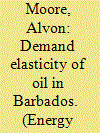

|
|
|
|
|
| Publication |
2011.
|
| Summary/Abstract |
The importation of oil is a significant component of Barbados' imports, rising from 7% of imports in 1998 to over 20% in 2009. This increase has impacted greatly on the level of foreign reserves. As a price-taker, relying entirely on imported oil for our energy needs could prove a continuous drain on the economy. With a view to formulating an appropriate energy policy for Barbados, this paper analyses the demand for oil using monthly data from 1998 to 2009. The paper estimates the elasticities of demand for oil by employing PesAran (2001) single equation cointegration approach and comparing the results with countries that rely heavily on imported oil and whose policy objective are to alter their energy structure to rely less on imported oil. The results show that the demand for oil imports is price inelastic in the long run. The consumption of oil is responsive to past consumption, prices, income, electricity consumption and the number of appliances imported in the short-run. A policy framework to reduce the use of oil for electricity consumption via alternative energy sources should be considered and the taxation of oil imports given its elasticity is a good source of revenue.
|
|
|
|
|
|
|
|
|
|
|
|
|
|
|
|
| 6 |
ID:
072609


|
|
|
|
|
| Publication |
2006.
|
| Summary/Abstract |
The rapid growth of energy demand, the lagging growth of energy production and rising pollution problems have raised concerns in several policy areas, including the availability and cost of energy supply and the possibility of further adverse impacts on the environment. This paper begins with an overview of recent developments in energy demand and supply in China. Using a traditional demand elasticity approach, it analyzes the elasticity of each of four major energy end uses and the potential for adjustments in their relationships. The paper concludes with suggestions for public policy to meet the challenge of growing energy demand and implications for the private sector, including both private and foreign investments.
|
|
|
|
|
|
|
|
|
|
|
|
|
|
|
|
| 7 |
ID:
085709
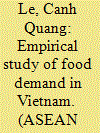

|
|
|
|
|
| Summary/Abstract |
This paper uses a linear approximation of Almost Ideal Demand System (AIDS) and extended AIDS models to investigate food consumption in Vietnam using the Vietnam Living Standard Survey (VLSS) in 2004. In particular, AIDS models are estimated to calculate income and price elasticities for three different components of food categories. Our results suggest that rice food and meat/fish are normal goods, while non-rice food is luxury. Household characteristics such as age, gender, and education do not appear to affect food consumption significantly, while urban/rural location is important. These results may give empirical evidence for policy-makers to design food policy in Vietnam.
|
|
|
|
|
|
|
|
|
|
|
|
|
|
|
|
| 8 |
ID:
115161
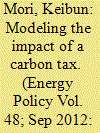

|
|
|
|
|
| Publication |
2012.
|
| Summary/Abstract |
In recent years, energy policy makers have proposed a carbon tax as an economy-wide policy tool to curb greenhouse gas (GHG) emissions. The quantification of its impact on GHG emissions has relied on an energy-economy model, whose complexity often makes it difficult to comprehend how it simulates the interaction of a carbon tax and energy demand. This study therefore aims at developing an alternative model called the Carbon Tax Analysis Model (C-TAM). The elasticity-based approach used in C-TAM is less sophisticated than an equilibrium-based approach used in an energy-economy model, but C-TAM is designed to maximize its predictive capabilities by using a wide range of elasticities for each sector and fuel use, accounting for likely changes in fuel mix for electricity generation, and addressing the model's sensitivity to elasticity estimates with Monte Carlo simulation. The trial analysis in this study evaluates a potential carbon tax in Washington State, suggesting a carbon tax at US$30 per metric ton of CO2 (tCO2) lowers GHG emissions by 8.4% from the business-as-usual (BAU) scenario in 2035. The study concludes that C-TAM can provide meaningful policy implications by forecasting detailed impact on revenues and energy demand for each sector and fuel use.
|
|
|
|
|
|
|
|
|
|
|
|
|
|
|
|
| 9 |
ID:
176733
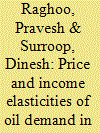

|
|
|
|
|
| Summary/Abstract |
There are no studies that quantify the effects of price and income on the demand of fuel oil, gasoline and diesel oil in Mauritius. In line with increasing retail prices for these commodities, there is no estimation of the effect that increasing price, income and other variables like electricity and vehicle stock have on demand of petroleum products which affects effective policymaking in this area. This study uses an ARDL–ECM model to determine consumer response on petroleum demand when price and income in Mauritius changes. The study determines the income and price elasticities of demand which is a needed parameter in transportation and taxation policies. It was found that gasoline is price and income inelastic in the short–run, diesel oil is income inelastic in the long–run and fuel oil is inelastic in the short–run but becomes elastic in the long–run, other variables being not significant. The effect of rising electricity consumption on fuel oil demand was to a ratio of 1: 1.1 on average. Vehicle stock is estimated to cause unprecedented increase in gasoline demand by nearly 3.1% on average. Results are essential for transportation and energy taxation policymaking.
|
|
|
|
|
|
|
|
|
|
|
|
|
|
|
|
| 10 |
ID:
176833
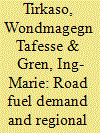

|
|
|
|
|
| Summary/Abstract |
This study estimated national and regional-level gasoline and diesel demand elasticities in Sweden using county-level panel data from 2001 to 2018. The estimated elasticities were used to calculate county cost effect of the Swedish CO2 emission reduction policy in the transport sector. The national-level elasticities were estimated by employing general method of moments (GMM) estimators, while county-level elasticities were calculated by considering the weight of each fuel type share at county and national levels. Own prices, per capita income, and per capita vehicle stocks were statistically significant at national level in determining gasoline and diesel demand. The calculated regional price elasticities showed variation between counties, with the highest being almost 4 times higher than the lowest in absolute terms. A simulation of fuel taxes to achieve the Swedish 2030 emission target for the transport sector under the national and regional price elasticities indicated minor differences at the national level with respect to CO2 taxes, costs and regressivity in the taxes. The results showed considerable differences at the regional level where costs and carbon tax payments can be considerably higher for some counties with the use of national price elasticities and the opposite is the case for other counties.
|
|
|
|
|
|
|
|
|
|
|
|
|
|
|
|
| 11 |
ID:
128383
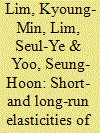

|
|
|
|
|
| Publication |
2014.
|
| Summary/Abstract |
This paper attempts to examine the electricity demand function in the Korean service sector using the annual data covering the period 1970-2011. The short- and long-run elasticities of electricity demand with respect to price and income are empirically estimated using a co-integration and error-correction model. The short- and long-run price elasticities are estimated to be -0.421 and -1.002, respectively. The short- and long-run income elasticities are computed to be 0.855 and 1.090, respectively. Electricity demand in the service sector is inelastic to changes in both price and income in the short-run, but elastic in the long-run. Therefore, it appears that a pricing policy is more effective than the direct regulation of reducing electricity demand in the long-run in order to stabilize the electricity demand in the service sector. Moreover, it is necessary to encourage a more efficient use of electricity to cope with increasing demand for electricity following economic growth because the electricity demand in the service sector is income-elastic in the long-run.
|
|
|
|
|
|
|
|
|
|
|
|
|
|
|
|
| 12 |
ID:
112893


|
|
|
|
|
| Publication |
2012.
|
| Summary/Abstract |
We empirically estimate the demand for gasoline in the presence of multiple shifts caused by structural breaks using monthly data from Lebanon covering the period 2000:M1-2010:M12. Consistent with most studies in the literature, our study reports that gasoline is price and income inelastic in the short-run. However, when a single and multiple breaks are introduced, the consumers' responsiveness to gasoline price and income increase. Since both price and income elasticity are sensitive to structural changes, a policy that pleads for a flat excise tax may not be optimal with respect to either the cyclical pattern of government revenues or the internalization of international environment standards.
|
|
|
|
|
|
|
|
|
|
|
|
|
|
|
|
| 13 |
ID:
176874


|
|
|
|
|
| Summary/Abstract |
This paper analyzes the direct impact of transport fuel price change on household welfare in India using a cross-sectional household consumption expenditure survey data. The results show that transport fuel is price elastic in both urban and rural areas across income groups, implying that the subsidy reform undertaken by the Government of India is an effective means to reduce the residential transport energy consumption. However, the relative welfare values show that lower- and middle-income groups remain more vulnerable to transport fuel price changes, thus, suggesting a regressive effect. Since households do not have an affordable substitution option for transport fuels like petrol and diesel, decarbonizing transport sector needs investing in alternate fuels, technology and infrastructure. However, for sustainability and inclusion to go hand-in-hand, mere switching to alternate or cleaner fuel sources is not sufficient. It is imperative to encourage the use of public transport in India, considering the increasing transport demand due to the rising middle-income population and rapid urbanization. Along with it, the policy makers could consider offsetting the subsidy removal by a targeted compensation scheme which will not just ensure making the transition more inclusive, but also serve as a long term sustainable development strategy.
|
|
|
|
|
|
|
|
|
|
|
|
|
|
|
|
|
|
|
|
|